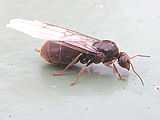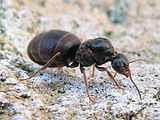Black garden ant
| Black garden ant | |
|---|---|
 | |
| Conservation status | |
| Not Evaluated | |
| Scientific classification | |
| Kingdom: | Animalia |
| Phylum: | Arthropoda |
| Class: | Insecta |
| Order: | Hymenoptera |
| Family: | Formicidae |
| Subfamily: | Formicinae |
| Genus: | Lasius |
| Species: | L. niger |
| Binomial name | |
| Lasius niger (Linnaeus, 1758) | |
The black garden ant (Lasius niger), also known as just common black ant, is a formicine ant, the type species of the subgenus Lasius, found all over Europe and in some parts of North America and Asia. The European species was split into two species; L. niger is found in open areas, while L. platythorax is found in forest habitats.[1] It is monogynous, meaning colonies have a single queen.
Lasius niger colonies can reach in size up to around 40,000 workers but 4,000–7,000 is around average. A Lasius niger queen can live up to around 15 years.
Lasius niger is host to a number of temporary social parasites of the Lasius mixtus group including Lasius mixtus and Lasius umbratus.
Appearance
| Attribute | Description |
|---|---|
| Caste | Monogyn |
| Queen phenotype | 9 mm long, glossy black colour but appears to have slight brown stripes on her abdomen. The queen can reach 6-9mm in length and is smaller as a new queen. When a queen is fertilised she removes her wings and digests her wing muscles as food over the winter. |
| Drone phenotype | 3,5–4,5 mm long, slim, colour black. Only produced by queens when the nuptial flights are approaching. They appear with a dark glossy body with a different shape from the workers, almost resembling a wasp appearance. They have wing muscles which stand out from the rest of the body. They are 5-7mm long and have delicate wings |
| Worker phenotype | 3–5 mm long, workers are dark glossy black. As the colony gets older it has been known for workers to increase in size over generations |
| Soldier phenotype | N/A |
| Nest building | Nests underground, commonly under stones, but also in rotten wood |
| Nutrition | Nectar, small insects, fruit, will farm aphids |
Life cycle


Mating flights
Ants mate on the wing, so "flying ants" are males and immature queens. Mating / nuptial flights of Lasius niger usually occur around June to September throughout the species' range; in North America flights usually occur during the autumn, whereas in Europe they generally take place during the hot summer months of July and August. Flights can contain thousands of winged males and females.[2]
Disparities between local weather conditions can cause nuptial flights to be out of phase amongst widespread populations of L. niger. During long-lasting, hot summers, flights can take place simultaneously across the country, but overcast weather with local patches of sunshine results in a far less synchronised emergence of alates (winged individuals).
Once the queens have mated they will land and discard their wings and begin to find a suitable place to dig a tunnel. Meanwhile the males generally only live for a day or two after the mating flights and will then die.
New nest
After removing her wings, a queen will move quickly to find moist ground, then start digging a tunnel. Once the tunnel has been completed, the queen will block the entrance and retreat to the bottom. Subsequently, she will dig out a small chamber. This will serve as the founding chamber of the new colony. Generally, a queen will begin to lay eggs immediately after the construction of the chamber, and the eggs will hatch after 8–10 weeks. Until the eggs hatch and the larvae grow to maturity, a Lasius niger queen will not eat, relying on the protein of her wing muscles to be broken down and digested. In some cases, a Lasius niger queen may eat her own eggs in order to survive.
Egg to ant
Lasius niger have 4 stages of development: egg, larva, cocoon, and adult. Lasius niger lay tiny, white, kidney-shaped eggs with a smooth sticky surface which helps them to be carried in a group instead of one by one. After hatching Lasius niger proceed onto the larva stage resembling tiny maggots. The larvae need to be fed by the queen (or workers in the case of an established colony) if they are to mature; as they feed the larvae grow, shedding their skin, doing so usually three times in total. With each molt the larvae grow hooked hairs which allow them to be carried in groups. When Lasius niger larvae reach the last molt they are generally too big to be carried as part of a group and so are carried singularly. Once the larva grows big enough it spins a cocoon around itself. To aid this process a queen (or workers) may bury the larva so that it can spin its cocoon undisturbed, and begin a process of metamorphosis. Once the process is complete the Lasius niger worker emerges from the cocoon. At this stage Lasius niger is completely white but will darken over the course of an hour until it has turned black.
Colony established
The first worker ants that emerge are very small compared to later generations. At this point the workers immediately begin to expand the nest and care for the queen and brood; they eventually remove the seal from the entrance to the nest and begin to forage above ground. This is a critical time for the colony as they need to gather food quickly to support future growth and particularly to feed the starved queen, who would have lost around 50% of her body weight. From this point on the queen's egg laying output will increase significantly, becoming the queen's sole function. The later generations of worker ants will be bigger, stronger and more aggressive, because there is more nutrition for them at the larval stage. The initial brood being fed only by the scarce resources available to a queen will be much smaller than brood supported by a team of foraging and nursing workers. Provided workers are able to find food at this stage the colony will see an exponential rise in population. After several years, once the colony is well established, the queen will lay eggs that will become queens and males. Black ants often make large nests with extensive tunnel connections.
As a pest
In the garden
This type of ant is a problem for some gardeners. They will farm aphids for the honeydew they excrete by bringing them inside the nest and bringing them back out again when necessary. The ants will also eat ripe fruits, especially fruits like strawberries that lack a thick protective skin. Lasius niger also feed on insects and spiders, and other small invertebrates. In Ireland they are usually referred to as pismires, an archaic term for an ant.
In the home
Black garden ants often explore their surroundings quite extensively during early summer months in an effort to increase the food supply to their queen and her young, and also as a way of testing new ground in preparation for the nests' summer flight. In some cases, these explorations lead to a burrowing through mortar and brick.
References
- ↑ Klotz, John H. (2008). Urban Ants of North America and Europe: Identification, Biology, and Management. Cornell University Press. pp. 39–44. ISBN 0801474736.
- ↑ http://biology.arizona.edu/sciconn/lessons2/Shindelman/teacher/Page2.htm
External links
| Wikimedia Commons has media related to Lasius niger. |